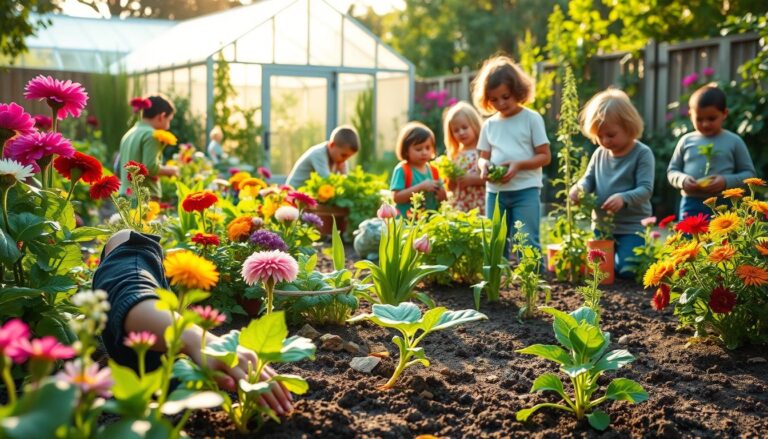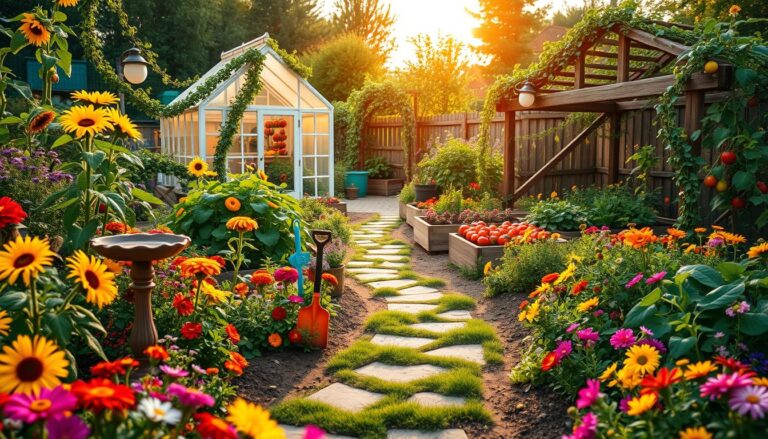Gardening fans know that proper plant care is key for lush, vibrant plants. Pruning and trimming are crucial. They help control growth, promote health, and improve looks.
By using tips for successful pruning and trimming, you can have beautiful, thriving plants. These plants will make your garden or indoor space more beautiful and valuable. The right pruning and trimming techniques can greatly improve your plants’ health and looks.
With the right pruning and trimming advice, you’ll create a stunning garden or indoor oasis. This oasis will bring joy and peace to your life.
The Science Behind Plant Growth and Maintenance
To prune and trim well, you need to understand how plants grow. Plants change in complex ways when cut or pruned.
How Plants Respond to Cutting
When plants are cut, they start to heal right away. They seal the wound to keep water in and prevent infections.
Growth Hormones and Their Role
Growth hormones, like auxins, are key in plant growth and how they react to pruning. Auxins help cells grow and divide, guiding plant growth.
| Hormone | Function |
|---|---|
| Auxins | Promote cell elongation and cell division |
| Cytokinins | Regulate cell division and differentiation |
| Ethylene | Influences fruit ripening and senescence |
The Healing Process After Pruning
After pruning, plants start to heal. They form callus tissue over the cut. This tissue grows into a protective layer, keeping the plant safe from harm.
Understanding the Difference Between Pruning and Trimming
Pruning and trimming are often mixed up, but they have different roles in plant care. Knowing the difference helps keep your plants healthy and looking good.
What is Pruning?
Pruning means cutting off parts of a plant, like branches or roots, to make it healthier and stronger. It’s a deeper method used to fix or enhance the plant’s shape.
What is Trimming?
Trimming is a lighter touch that involves cutting back branches or stems to keep a plant’s shape or size. It’s mainly for looks.
When to Use Each Technique
Deciding between pruning and trimming depends on what you want for your plant. Prune for health, growth, or to fix damage. Trim to keep shape or size in check.
Impact on Plant Health and Appearance
Both pruning and trimming affect a plant’s health and looks. Proper pruning can improve a plant’s natural shape and encourage growth. But over-trimming can stress the plant and cause disease or pests.
By knowing when to prune and trim, gardeners can keep their plants thriving and beautiful.
Expert Pruning and Trimming Advice for Healthy Plants
Knowing how to prune and trim is key for any gardener. It keeps your plants looking great and healthy. These practices are vital for your garden’s beauty and your plants’ well-being.
Basic Principles to Follow
There are a few basic rules for pruning and trimming. Always use clean, sharp tools to avoid disease. Know how your plants grow to prune them right. Pruning at the right time is also important for healing and growth.
Setting Clear Goals Before You Start
Before you start, know what you want to achieve. Do you want to encourage new growth, improve flowering, or keep the plant’s shape? Having a clear objective will guide your actions.
Safety Considerations
Always put safety first when pruning or trimming. Wear gloves and safety glasses to protect yourself from thorns and debris. Make sure you’re in a safe place and have good footing.
Reading Your Plant’s Signals
Plants often show signs they need pruning or trimming. Look for dead or diseased branches and any crossing branches that could harm. Observing your plants regularly helps you catch these problems early.
| Pruning/Trimming Task | Purpose | Best Time to Perform |
|---|---|---|
| Removing Dead Branches | Promote Health | Anytime |
| Shaping Plants | Enhance Aesthetics | Dormant Season |
| Encouraging New Growth | Boost Vigor | Early Spring |
By following these expert tips, you can keep your plants healthy and thriving. Remember, pruning and trimming are more than just cutting back. They’re about caring for your garden so it can flourish.
Must-Have Tools for Effective Pruning and Trimming
Pruning and trimming are key to keeping plants healthy and looking great. The right tools make these tasks easier and prevent plant damage.
Hand Pruners and Shears
Hand pruners and shears are essential for gardeners. They help cut and trim small branches and stems. High-quality hand pruners should be sharp, easy to hold, and simple to clean.
Loppers and Pruning Saws
Loppers and pruning saws are vital for thicker branches. Loppers offer extra leverage, and pruning saws cut through larger limbs. Choosing the right saw is crucial for plant health.
Hedge Trimmers and Specialty Tools
Hedge trimmers are great for shaping hedges and shrubs. Tools like rose pruners and vine clippers meet specific plant needs. These investments boost your pruning skills.
Maintaining Your Pruning Tools
Keeping pruning tools in good shape is crucial. Clean and sharpen them after each use to stop disease spread and ensure clean cuts.
| Tool | Use | Maintenance Tip |
|---|---|---|
| Hand Pruners | Cutting small branches | Sharpen blades regularly |
| Loppers | Cutting thicker branches | Clean and oil hinges |
| Pruning Saws | Cutting large limbs | Replace blades as needed |
Seasonal Guide: When to Prune Different Plants
To keep your plants healthy, knowing when to prune is key. Each season has its own pruning needs. Understanding these can greatly benefit your plants’ health and look.
Spring Pruning Guidelines
Spring is a time of renewal. Pruning in spring can help plants grow new. It’s best for plants damaged in winter or needing a shape-up before growing starts.
Remove dead or damaged branches. This lets healthy growth happen.
Summer Maintenance Trimming
Summer is for keeping plants in check, not for big cuts. Trim overgrown branches, shape hedges, and remove suckers or water sprouts. This keeps your plants neat and promotes healthy growth.
Fall Preparation Cuts
In fall, get your plants ready for winter. Cut out diseased, damaged, or dead branches. Also, shape your plants and cut back perennials to the ground.
Winter Dormant Pruning
Winter is the best time for big pruning. Many plants are dormant, reducing disease risk. It’s a great time for pruning deciduous trees and shrubs.
Exceptions to Seasonal Rules
While these guidelines are useful, some plants need special care. For example, prune spring-flowering shrubs after they bloom, not in spring. Always check what your plants need.
| Season | Pruning Activity | Plant Type |
|---|---|---|
| Spring | Stimulate new growth, remove winter damage | Most plants, especially those damaged in winter |
| Summer | Maintenance trimming, shaping | Hedges, overgrown branches |
| Fall | Prepare for winter, remove diseased or dead branches | Perennials, diseased or damaged plants |
| Winter | Major pruning, shaping | Deciduous trees and shrubs |
Step-by-Step Techniques for Common Garden Plants
Learning how to prune and trim is crucial for a lush and stunning garden. Each plant needs its own special care to stay healthy and look great.
Pruning Flowering Shrubs
Pruning flowering shrubs needs to be done at the right time. Spring-blooming shrubs should be pruned after they’ve finished blooming. On the other hand, summer-blooming shrubs are best pruned in late winter or early spring.
- Remove dead or damaged branches to prevent disease and encourage healthy growth.
- Cut back overgrown branches to maintain shape and promote new growth.
- Thin out the center to allow more sunlight to penetrate and improve air circulation.
Trimming Hedges and Topiaries
Trimming hedges and topiaries needs precision and the right tools. Use sharp hedge trimmers for clean cuts and to avoid tearing leaves.
- Start by removing any dead or damaged sections.
- Trim the hedge to maintain its desired shape, working from the bottom up.
- Use a string or level to ensure straight edges.
Managing Fruit Trees
Fruit trees greatly benefit from regular pruning. This not only boosts their productivity but also keeps them healthy.
- Remove any branches that are dead, diseased, or damaged.
- Thin out the tree to allow more sunlight to reach the fruiting branches.
- Prune to maintain a balanced structure and promote healthy growth.
Caring for Ornamental Trees
Ornamental trees add beauty to any garden. Pruning them correctly is key to keeping their shape and health.
| Pruning Task | Benefit |
|---|---|
| Removing dead branches | Prevents disease and promotes healthy growth |
| Thinning out the canopy | Improves air circulation and sunlight penetration |
| Shaping the tree | Maintains aesthetic appeal and structural integrity |
Handling Perennials and Grasses
Perennials and grasses need regular care to look their best. The pruning method varies by plant type.
For perennials, cut back dead foliage in early spring to make way for new growth. Ornamental grasses should be pruned in late winter or early spring, removing dead foliage to ground level.
By following these step-by-step techniques, gardeners can ensure their plants stay healthy, vibrant, and well-maintained all year.
Special Care for Popular Plant Varieties
Popular plants like roses and evergreens need special care to look their best. Knowing what they need is key for a vibrant garden.
Rose Pruning Techniques
Roses are a favorite in many gardens. Pruning them is both an art and a science. Prune roses in late winter or early spring when they’re dormant.
Remove dead, diseased, or damaged branches first. Then, shape the bush by cutting tall canes to 12-18 inches from the ground. Make cuts at a 45-degree angle just above an outward-facing bud.
Hydrangea Pruning Guide
Hydrangeas are known for their stunning flowers. Pruning them right can make their blooms even better. The timing of pruning varies by hydrangea type.
For bigleaf hydrangeas, prune after they finish blooming in summer. Remove spent flowers and cut back dead or damaged stems. Prune panicle and smooth hydrangeas in late winter or early spring, cutting back to a pair of healthy buds.
Managing Climbing Vines
Climbing vines add interest to gardens. They need regular pruning to stay in check and bloom well. Prune them in late winter or early spring, removing dead or damaged stems.
Train the vines by gently twining them around their support or using soft ties to secure them.
Pruning Evergreens and Conifers
Evergreens and conifers add color and structure all year. Prune them in late winter or early spring to keep them looking good. Remove any dead, diseased, or damaged branches, cutting them off at the base to prevent disease spread.
Caring for Flowering Trees
Flowering trees bring beauty and vibrancy to landscapes. Prune them after they finish blooming to keep their shape and promote growth. Remove any crossing or rubbing branches, as well as dead, diseased, or damaged wood, to keep the tree healthy.
By following these expert pruning and trimming tips, gardeners can give their plants the best care. This will enhance their beauty and longevity.
Indoor Plant Pruning: Special Considerations
To keep your indoor plants thriving, understanding pruning is key. Indoor plants need special care compared to outdoor ones. Their pruning is different.
Houseplant Trimming Basics
Trimming houseplants is more than cutting off excess growth. It’s about keeping them healthy and promoting new growth. Start by removing dead or dying leaves and stems to stop disease.
Use clean, sharp tools for precise cuts. Avoid tearing the plant’s tissues. Prune during the growing season (spring and summer) for best results.
Dealing with Leggy Growth
Leggy growth is common in indoor plants, often due to too little light. To fix this, prune back the leggy stems. This encourages branching and a fuller look. It also helps the plant grow healthier.
Propagation Through Pruning
Pruning can help you grow new plants. Many houseplants can be propagated through cuttings. Cut a healthy stem, remove lower leaves, and plant it in moist soil. Keep it warm and humid until roots grow.
Seasonal Indoor Plant Care
Indoor plants have different needs by season. While pruning is more aggressive in the growing season, some plants need it at other times. Know your plant’s needs and prune accordingly.
Follow these pruning and trimming advice tips to keep your indoor plants healthy. The key is to understand your plant’s unique needs and act on them.
Common Pruning and Trimming Mistakes to Avoid
Many gardeners face challenges with pruning and trimming. These issues often stem from common errors. Knowing these mistakes is key to keeping plants healthy and lively.
Over-Pruning: Signs and Consequences
Over-pruning can harm plants, causing disease and attracting pests. Look out for signs like too much sap flow, dieback, and less flowering or fruiting.
Improper Cutting Techniques
Incorrect cuts can hurt plants. Always cut just above a growth node, at a 45-degree angle. This helps plants grow back strong.
Ignoring Plant-Specific Needs
Each plant has its own pruning needs. Learning these can help avoid mistakes.
Using Dull or Dirty Tools
Dull tools can rip plant tissue, while dirty ones spread disease. Keeping your tools sharp and clean is crucial.
Poor Timing Decisions
Pruning at the wrong time can mess with a plant’s growth. Knowing when to prune is key for health and blooms.
Let’s look at how proper pruning and trimming can make a difference:
| Pruning Practice | Positive Outcome | Negative Outcome |
|---|---|---|
| Pruning at the right time | More flowers and fruit | Less flowers and fruit |
| Using sharp, clean tools | Healthy cuts, less disease | Disease spread, torn cuts |
| Pruning according to plant needs | Encourages right growth | Stress, disease, pests |
Avoiding these common errors can greatly improve your plants’ health and look. Pruning and trimming well takes time and practice.
The Benefits of Proper Pruning and Trimming
Pruning and trimming are more than just cutting plants. They help plants stay healthy and look great. These practices bring many benefits of pruning and trimming. When done right, they make your garden better.
Improved Plant Health and Vigor
Removing sick, broken, or dead branches is key. It stops diseases from spreading and helps plants grow strong. This lets plants focus on growing well.
Enhanced Flowering and Fruiting
Pruning at the right time and way boosts flowers and fruits. It shapes plants to help blooms and fruits grow better.
Better Aesthetics and Form
Pruning and trimming keep plants looking good. Regular care makes your garden look amazing.
Disease and Pest Management
Pruning gets rid of disease and pests. It’s a big part of expert pruning and trimming guidance.
Extended Plant Lifespan
Regular pruning and trimming make plants live longer. It reduces stress and promotes healthy growth. This means your plants stay healthy for a long time.
Learning expert pruning and trimming guidance helps gardeners. They get healthier, more vibrant plants and a stunning garden.
Conclusion: Growing Your Confidence and Your Garden
With the right pruning and trimming advice, you can unlock your garden’s full potential. Understanding plant growth and maintenance helps you make better decisions for your plants.
By using the tips from this article, you’ll promote healthy growth and vibrant blooms. You’ll also keep your landscape looking great. As you get better at pruning and trimming, you’ll handle tough plants with ease.
Pruning and trimming are more than just cutting plants. They help you connect deeper with your garden. Follow the expert advice and techniques to create a lush, thriving outdoor space. This space will bring joy and beauty to your life.
FAQ
What’s the difference between pruning and trimming?
When is the best time to prune and trim my plants?
What are the most common mistakes to avoid when pruning and trimming?
What are the essential tools for pruning and trimming?
How do I know if I’m over-pruning my plants?
Can pruning and trimming help with disease and pest management?
How do I properly maintain my pruning tools?

Sortemdia nasceu com o propósito de trazer alegria e oportunidades para todos por meio de sorteios gratuitos de prêmios incríveis. O site tem como missão oferecer experiências acessíveis, divertidas e justas para quem deseja concorrer a produtos, serviços e brindes sem pagar nada por isso. Acreditamos que a sorte pode bater à porta de qualquer pessoa — e no Sortemdia, ela pode chegar com apenas um clique.



